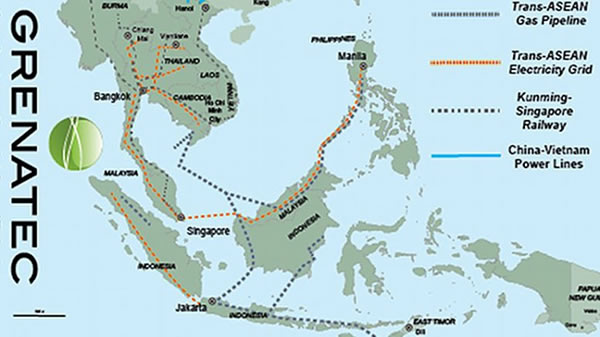China’s Asian Infrastructure Investment Bank’s (AIIB) first investment should be — without a doubt — the Trans-ASEAN Gas Pipeline (TAEG) and Trans-ASEAN Electricity Grid (TAEG).

No other Asian infrastructure project is as ‘shovel ready’ and achieves as many positive outcomes for China, Asia and the world.
The TAEG is estimated to cost US$6 billion, the TAGP $7 billion. Their combined $13 billion cost amounts to about 13% of the AIIB’s $100 billion capital.
That’s a highly manageable sum for the bank’s first loan, which China wants to make this year.
What’s more, both the TAEG and TAGP fit perfectly into China’s One Belt, One Road concept.
They also complement other proposed China-led Asian infrastructure projects. These include, for instance, the Kunming-Singapore Railway. At $40 billion, that’s a far bigger project. But it could follow on from completion of the TAGP and TAEG.
Together, the TAGP, TAEG and Kunming-Singapore Railway offer a confidence-building regional economic development template for China and Southeast Asia. The three projects — and particularly the TAGP — could lead to enough mutual confidence and goodwill for China and her Southeast Asian neighbors to agree on Joint Development Areas (JDAs) for oil and gas in the South China Sea.
JDAs are a concept all countries in the region support in principle as an alternative to war over mostly uninhabited rocks, many of which disappear during high tide.
Deepening gas, electricity and train connections between the Chinese and ASEAN economies will speed regional decarbonization of energy markets. This will generate economic wealth.
It can also help break the ice between China and her Southeast Asian neighbors over hot button South China Sea territorial issues.
The best long-term solution in the South China Sea — one that all sides support in principle — is through creating Joint Development Areas (JDAs) for exploration and development of oil and gas resources.
The TAGP project largely lies outside the South China Sea’s most geographically contested areas. That can enable it to serve as a confidence builder for follow on cooperation.
The AIIB, for instance, could start by funding of a subsea natural gas pipeline connecting South Vietnam’s Mekong Delta, Indonesia’s Natuna islands and Malaysia’s Borneo. This has already been already proposed by the Association of Southeast Asian Nation States (ASEAN) through its TAGP project.
As part of project specifications, the pipelines could be made interconnection-ready for later extension northward to the shallow, near-shore waters off central and northern Vietnam and eastward to Philippine Palawan.
These extensions would provide access to highly-prospective natural gas fields east of central Vietnam’s Da Nang city and in the Reed Bank area off Philippine Palawan.
Off Da Nang, China National Offshore Oil Company’s (CNOOC) flagship, high-technology oil exploration rig Haiyang Shiyou 981 has explored near shore oil and gas prospects on three separate occasions. This has led to anti-Chinese riots in Vietnam.
Off Palawan, Philippine oil and gas explorer Philex has been on on-again, off-again negotiations with CNOOC over developing the Sampaguita field in the offshore Reed Bank.
Agreeing to greater cooperation between China, Vietnam and the Philippines in hot button areas like these that readily lend themselves to joint development can dial back territorial tensions. Both benefit from promising precedent.
For instance, Philippine energy company Philex and China’s CNOOC already have discussed — at least in preliminary form – joint development of Reed Bank. In the Tonkin Gulf, and China and Vietnam already are cooperating in managing offshore resources straddling the equidistance line between North Vietnam and China’s Hainan Island.
Joint development by China, the Philippines and Vietnam of the Sampaguita Field and Tonkin Gulf can lead to deeper integration of the region’s electricity grids and gas pipelines. China and Vietnam, for instance, already trade electricity across their common border. China’s State Grid is now upgrading and operate the Philippine electricity grid. Both offer precedent.
Projects like the above could dial down tensions between China and Southeast Asia. They could provide templates for management of more contested disputes.
These could include the offshore area northeast of Vietnam’s Danang city and east of the Tonkin Gulf. There, China’s Haiyang Shiyou 981 has parked three times over the past two years to explore for oil and gas in waters claimed by Vietnam. Further south, CNOOC has attempted to auction off oil and gas exploration leases in waters claimed by Vietnam.
These unilateral actions by China have significantly damaged political ties to no evident economic gain to China. Funding infrastructure in Southeast Asia linking Joint Development Areas in a comprehensive plan to create the energy networks of tomorrow in the region solves a host of problems at once.
China’s AIIB is an organization in a hurry. Somewhat optimistically, it aims to disburse its first loan by the middle of this year, even though it has still to hire much of its executive staff. Given this, the AIIB should make its first investments in known projects that already enjoy wide support.
The TAGP and TAEG are perfect examples. They lay the foundation for outward expansion over time southward to Indonesia and Australia and northward to connect China, Japan and South Korea across the East China Sea.
Along the way, a host of thorny issues will be first sidelined, and later solved through cooperation and investment, not conflict and warships.
China’s Asian Infrastructure Investment Bank’s (AIIB) first investment should be — without a doubt — the Trans-ASEAN Gas Pipeline (TAEG) and Trans-ASEAN Electricity Grid (TAEG).